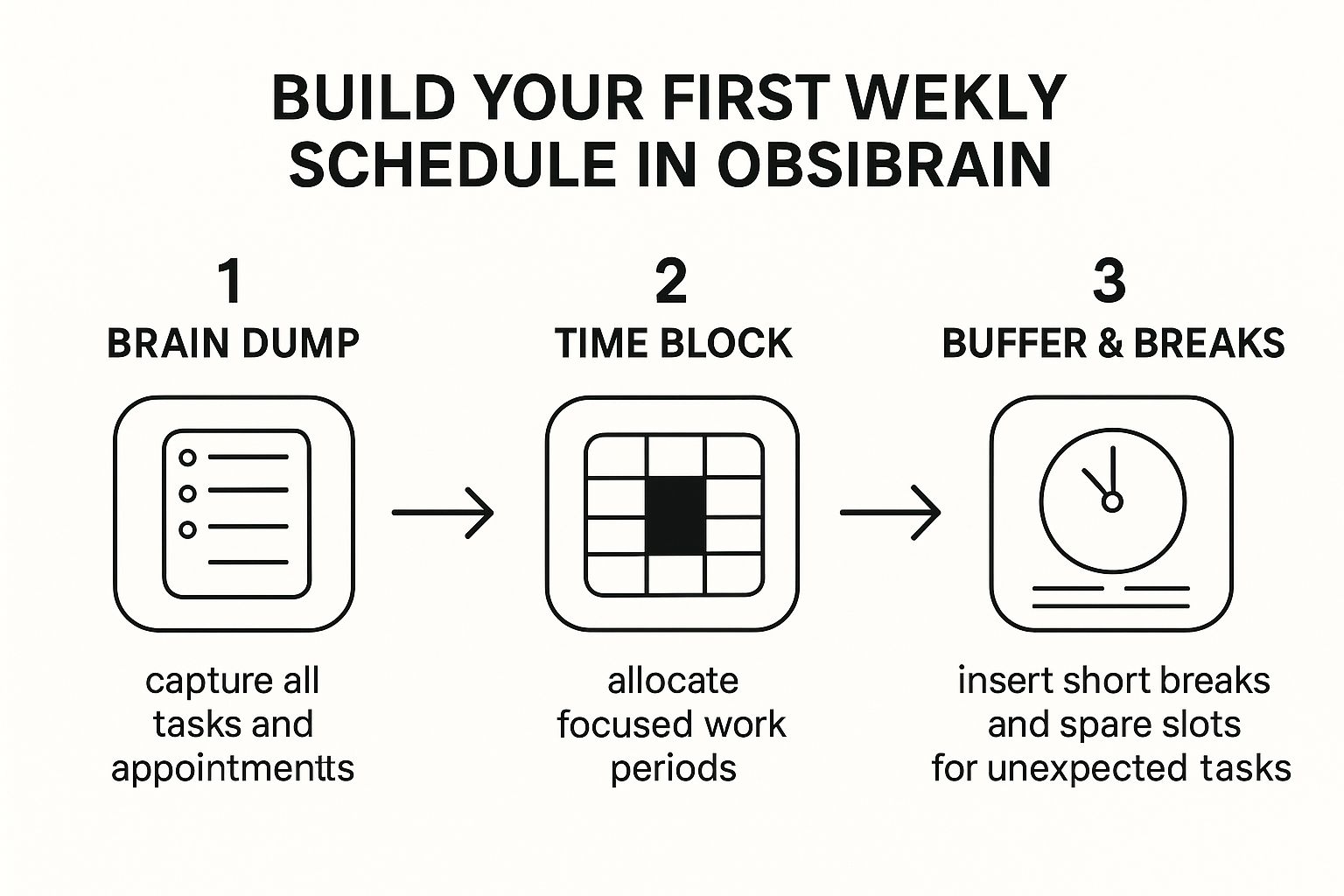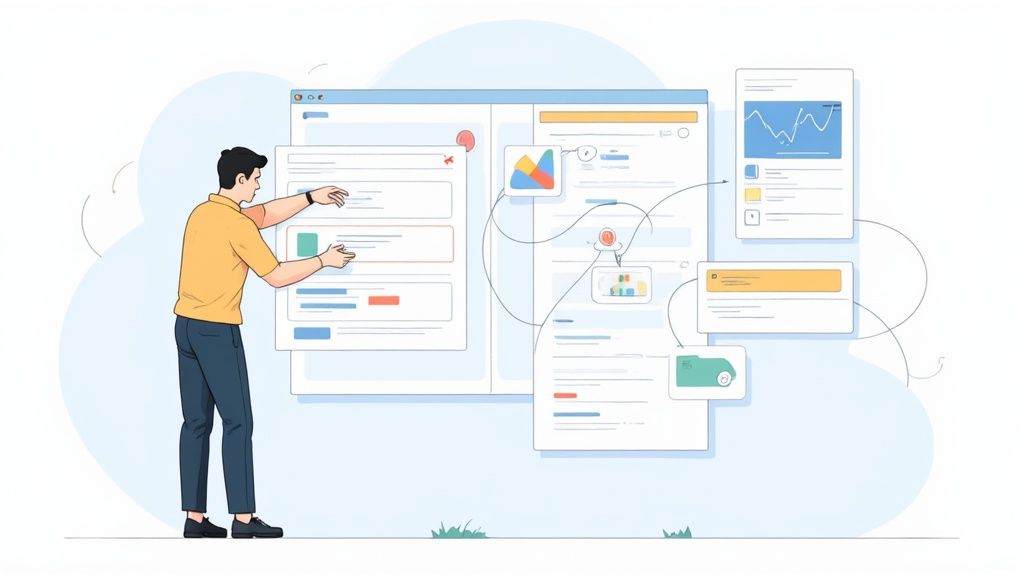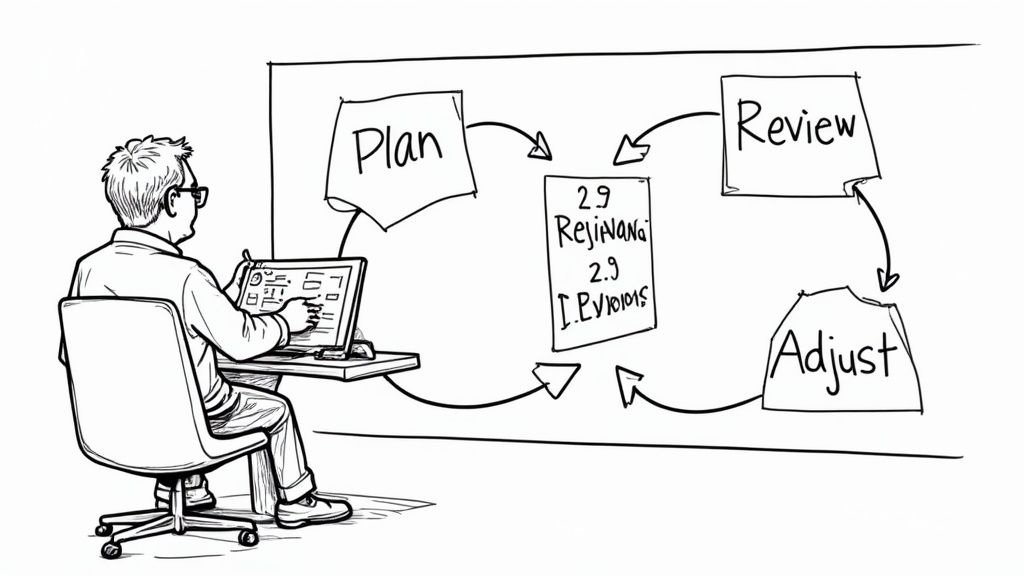Build Better Time Management Schedules in Obsibrain

Time management schedules are supposed to be structured plans that map out your day, helping you hit your goals and stay productive. But let's be real—the best ones are flexible. They have to be. They’re meant to turn a vague to-do list into a concrete set of commitments, but they also need to bend without breaking.
Why Your Time Management Schedules Keep Failing
We’ve all been there. You spend Sunday night meticulously crafting the perfect, color-coded weekly plan, feeling on top of the world. Then Monday afternoon hits. An unexpected client call, a project that blows past its time estimate, or a single "urgent" request is all it takes to send your beautiful schedule crumbling.
This is the fundamental flaw with old-school, rigid scheduling. It's built on the fantasy that our workdays are predictable. They aren't. If you're constantly wondering why your plans fall apart, it's probably because they were designed to. Digging into the root causes of solving your time management problems is a great place to start figuring this out.
The Disconnect Between Planning and Reality
The gap between our planned days and our actual work lives is massive. A wild 82% of people don’t even use a formal time management system, and it's no wonder. The average person is only genuinely productive for about 2 hours and 53 minutes a day, mostly thanks to constant interruptions.
When employees are hit with around 60 distractions daily, a static plan just doesn't stand a chance. This is exactly where a tool like the Obsibrain template in Obsidian changes the game. It’s built to be dynamic, not static.

This screenshot shows the very essence of how Obsidian works—notes, tasks, and ideas are all interconnected. It’s a visual web, the complete opposite of a rigid, linear to-do list. It actually mirrors the messy, non-linear way work really gets done.
The table below breaks down the common frustrations with traditional planning and highlights how a more integrated system provides a real solution.
Rigid Planning vs The Dynamic Obsibrain Method
Plans shatter with one unexpected task.
Flexible structure lets you drag, drop, and reschedule tasks without breaking the system.
Tasks are isolated, lacking context from notes or emails.
Tasks are linked directly to relevant meeting notes, research, and project files.
Hard to see the big picture when you're in the weeds.
The graph view visually connects projects, tasks, and ideas, showing you how it all fits.
Priorities are static and difficult to adjust on the fly.
Priorities are dynamic. You can easily adjust your focus as the day unfolds.
Ultimately, an adaptive system acknowledges reality: your day will change. The goal isn't to prevent that, but to handle it gracefully.
Moving Beyond To-Do Lists
A simple to-do list tells you what you need to do. A truly smart schedule also tells you when and how. This is the gap Obsibrain is designed to bridge, connecting your tasks directly to your notes, projects, and overarching goals.
The goal isn't to create a perfect, unbreakable schedule. It's to build a resilient system that helps you regroup and reprioritize quickly when—not if—your day gets disrupted.
Instead of just having an item that says "Write report," your Obsibrain schedule can link that single task to the meeting notes that kicked it off, the research articles you need to cite, and the client emails that contain key details. For a product manager, this means a task like "Plan Q4 sprint" isn't just a to-do; it's linked directly to user feedback notes, competitor analysis, and technical requirement documents, all within the same system. This context-rich approach transforms your schedule from a simple checklist into a powerful command center for your entire workflow.
It even makes it easier to build and maintain positive routines. You can learn more about how to weave personal development into your daily planning with Obsibrain's habits tracking features: https://docs.obsibrain.com/features/habits-tracking.
Your First Steps with the Obsibrain Template
Jumping into a new system can feel like a huge commitment, but the real goal here is just to get moving. Forget about making it perfect right away. Think of this first session as clearing off your mental workbench so you can actually start building something. The Obsibrain template for Obsidian is built to get you from zero to organized without a massive learning curve.
While you're getting set up, you might want to check out the main TryOrbit platform to see the broader ecosystem. But once you have Obsidian and the template installed, the very first thing you'll do is probably the most impactful.
The Power of the Brain Dump
The first real step is to do a full "brain dump." This isn't just another item on your to-do list; it's the foundational act of getting every single commitment, idea, nagging thought, and deadline out of your head and into a system you can trust.
There's a reason this works so well. Cognitive psychology has shown that our working memory gets seriously bogged down when we try to hold onto too many things at once. By offloading all of it into Obsibrain, you free up that mental bandwidth to actually do the work instead of just remembering it exists.
The magic happens the moment your brain finally trusts that nothing will be lost or forgotten. That's when your new system truly starts to lighten the load, dialing down that low-level anxiety that comes from mentally juggling everything.
To get started, just open up your Daily Note—it's a core part of the template. Don't worry about order, priority, or categories yet. Just type.
For a project manager: List out all project milestones, upcoming team check-ins, budget reports due, and stakeholder emails you need to send.
For a student: Jot down every upcoming assignment, exam date, required reading, group project meeting, and research idea.
For a freelancer: Capture all client deadlines, prospecting follow-ups, invoicing tasks, and personal brand content ideas.
Even toss in creative ideas or long-term goals you want to think about later.
Finding Your Core Components
Once you’ve emptied your head, you'll start to see how Obsibrain is designed to handle this raw information. The template keeps things simple on purpose, so you won’t get lost clicking through a dozen features you don't need yet. You'll really only be working with a few key areas to get your first schedules built.
Most of the items from your brain dump can be moved right into the Task Manager. This is your command center for anything that needs action. From there, you can start adding due dates or linking tasks to specific project notes, which begins to build the interconnected web that makes this whole system so powerful.
If you want a more detailed walkthrough, the official documentation on how to get started with Obsibrain is an excellent resource with clear, step-by-step instructions.
Don't stress about getting this initial setup perfect. Just getting everything out of your mind and into this structure is a massive first win.
Crafting Your First Weekly Schedule in Obsibrain
Alright, you've done the brain dump—every last task, appointment, and stray thought is now out of your head and into Obsibrain. Now for the fun part: turning that raw list into a functional, actionable plan for your week.
This isn't about creating a rigid, unforgiving schedule that shatters the moment life happens. It’s about intentionally designing your week to make real progress.
The key to this is a technique called time blocking. Instead of staring at a massive to-do list and wondering where to start, you'll give your most important tasks their own dedicated spot on your calendar. This simple act is surprisingly powerful. It helps fight Parkinson's Law—the old adage that work expands to fill whatever time you give it. When you give a task a tight 90-minute block instead of a vague "afternoon," you'll be amazed at how much more focused you become.
Laying the Foundation with Time Blocks
Let's get practical. Open up your weekly view in Obsibrain. Now, start dragging your most critical tasks from your list into the empty time slots.
Think in real-world terms. A software developer might block out three hours on Tuesday morning for "Deep Work: Refactor Authentication Module" and a 90-minute block in the afternoon for "Code Review for Team." If you're a student, you'd treat study sessions like actual appointments, blocking out specific times for each subject before a big exam.
The secret is to be specific. A block just labeled "Work" is an invitation to procrastinate. "Draft Q3 marketing report" or "Code the user authentication feature" gives you a clear, immediate starting point, wiping out that "what should I do now?" decision fatigue.
This simple infographic breaks down the entire process into three core stages.

As you can see, it's not about cramming every minute with activity. It's a thoughtful flow: capture everything first, then allocate your time, and finally, protect those blocks.
Integrating Realism into Your Schedule
A schedule that's packed back-to-back with productive tasks is a fantasy. It looks great on paper but falls apart in the real world. Life is messy, and your plan needs to bend without breaking.
To build a schedule that can actually survive a real week, you need two things:
Buffer Time: Pencil in 15-30 minute gaps between your main time blocks. These are your shock absorbers. When a meeting runs long or a task is trickier than you thought, this buffer prevents your entire day from derailing.
Actual Breaks: Don't forget to schedule real breaks. I'm talking about intentional time away from your screen to stretch, grab a coffee, or just stare out the window. This isn't wasted time—it's what keeps you focused and prevents burnout.
For all those recurring tasks, like that weekly team sync every Tuesday at 10 AM, Obsibrain has you covered. Set it up once as a repeating task, and it will pop up on your schedule automatically. This takes care of your foundational commitments, freeing up your mental energy to plan around them. For a deeper dive, the official documentation has some great tips on Obsibrain's approach to daily planning.
Look, the goal isn't to follow your schedule perfectly down to the minute. That's impossible. The goal is to have a strong, realistic framework that helps you make smart decisions when the unexpected inevitably happens. Think of your schedule as a compass, not a cage.
Tailoring Obsibrain to Your Unique Workflow

Any schedule built on someone else's priorities is destined to fail. The real magic of a system like Obsibrain isn’t the template itself, but how you can mold it into an extension of your own mind. This is all about moving past generic to-do lists and building time management schedules that actually reflect the complexity of your work and life.
This is especially true for self-managed professionals. Freelancers, for example, often work longer hours than their office-based counterparts, despite having more flexibility. A 2023 survey revealed that while 31% work a standard 39-40 hour week, a whopping 29% put in up to 50 hours, and 9% work even more. This shows a clear need for a highly personalized system to manage those demands. You can dig deeper into how professionals are handling their time over at myhours.com.
Making the system your own starts with a few small, but powerful, customizations that can have a huge impact on your focus and clarity.
Creating a Personalized Tagging System
Tags are so much more than just labels; they're the connective tissue for your entire workflow. Instead of a generic #work tag, think about creating a structure that gives you instant context.
A content creator juggling an editorial calendar might use something like this:
#Blog/Draftfor posts that are still in progress.#Video/Scriptingfor YouTube content ideas.#Social/LinkedInfor platform-specific tasks.
On the other hand, a researcher tracking a complex project could use:
#Project-Alpha/LitReviewfor the literature review phase.#Project-Alpha/Data-Collectionfor active fieldwork.#Project-Alpha/Manuscriptfor the final writing stage.
This kind of specificity lets you see every related task and note for a specific part of a project with a single click. It's an instant way to cut through the noise.
Building Your Own Dashboards with Queries
This is where Obsibrain really starts to feel like your personal command center. With simple queries, you can create dynamic dashboards that automatically pull in exactly what you need to see, right when you need it.
For instance, you could build a "Today's Focus" section right on your Daily Note that shows you:
All tasks with today's due date.
Any notes you've tagged with
#Urgent.Meetings scheduled for this afternoon.
Use Case: A sales executive can create a dashboard that automatically pulls all tasks tagged with #FollowUp and notes from any client meeting that happened in the last seven days. This creates an instant, actionable list for the start of each day without any manual effort.
The goal is to design a system where information finds you, rather than you having to find the information. A well-built dashboard eliminates decision fatigue and lets you dive straight into meaningful work.
Linking Notes to Build a Knowledge Graph
Every single task on your schedule exists for a reason. It’s tied to a meeting, a project brief, a client request, or a research paper. The true power of Obsidian comes from making those connections explicit by linking information together.
When you add "Draft Client Proposal" to your schedule, don't just leave it there. Link it directly to the [[Client Acme Meeting Notes]] and the [[Project Scope Document]].
Over time, you start to build a powerful, interconnected knowledge graph. When you look at any single note, you can instantly see everything else it's connected to. This gives you a complete contextual overview that a simple calendar or to-do list could never match. It turns your time management schedules from flat lists into a three-dimensional map of your work.
Making Your New Scheduling Habit Stick

Let's be honest: a perfectly designed system is worthless if it just gathers digital dust. The real challenge isn't building a beautiful schedule in Obsibrain. It's showing up to use it every single day until it becomes second nature.
This is where we shift gears from system design to habit formation. It’s about making sure your new scheduling process actually sticks around for the long haul.
We’ve all been there—you spend a Sunday afternoon crafting the "perfect" weekly plan, only to have it fall apart by Tuesday morning. The real test isn't creating the schedule; it's being flexible when things inevitably go sideways. It's about building a resilient planning habit, not a rigid one.
The Weekly Review Ritual
One of the single most powerful habits you can build is the weekly review. Think of it as a non-negotiable appointment with yourself. Block out some time every Friday afternoon or Sunday evening to make it happen.
This isn't about planning new tasks. It's about reflecting on the week that just passed.
Inside your Obsibrain vault, just create a new note for your review. Then, ask yourself a few simple but potent questions:
What went well? Give yourself credit for the wins, no matter how small. Did you stick to your time blocks for that big project? Awesome.
What didn't go as planned? This is where the learning happens. Identify where your schedule broke down. Was it an unexpected meeting? A task that took twice as long as you thought?
What will I do differently next week? Here’s where you adjust. If a certain type of task consistently runs over, you now know to block more time for it next week.
This simple ritual turns your time management schedules from static documents into a dynamic, learning system that gets a little bit better every single week.
Handling Disruptions Without Derailing Your Day
Here’s a universal truth: no schedule survives first contact with reality. An urgent client email lands in your inbox, a critical software bug pops up, a last-minute request gets thrown your way—it happens.
The key isn't to prevent these things but to handle them gracefully without torching your entire day's plan.
When a disruption hits, don’t just throw your hands up and abandon the schedule. Take a breath and consciously decide what to do next. In Obsidian, you can quickly drag the interrupted task to a later time block or shunt it over to tomorrow’s Daily Note. This small action keeps you in the driver's seat.
The goal isn't perfect adherence to a schedule. It's about having a reliable system to return to when chaos inevitably strikes. Your schedule is your anchor, helping you quickly re-center and figure out what’s next.
Ultimately, your schedule has to evolve with you. As your projects and priorities shift, so will your daily plans. By embracing the weekly review and learning to adapt to disruptions, you’re not just managing time—you’re building a sustainable process that prevents burnout and keeps you moving forward, one well-planned day at a time.
Your Questions About Obsibrain Schedules, Answered
Jumping into a new way of managing your time is bound to bring up some questions. It's totally normal. While we've built Obsibrain to be as straightforward as possible, let's tackle some of the common things people wonder about when they first get started.
Getting your system right isn't just about learning the "how"—it's about understanding the "why" behind the features. This way, you're building a workflow that actually works for you, not just adding another app to your digital toolbox.
Is Obsidian Too Complicated if I'm a Beginner?
This is probably the number one concern I hear, and it's a fair one. Obsidian can look a bit intimidating at first glance, but templates like Obsibrain are specifically designed to flatten that learning curve. Seriously, you can be productive on day one by just sticking to the basics.
Think of it like learning to play the guitar. You don't need to master a complex solo on your first day. You start with the fundamental chords. Here, that means creating tasks in your Daily Note and slotting them into projects. The more advanced stuff, like custom queries and plugins, will still be there when you're ready to explore.
The goal isn't to master every single feature right away. It's to use the core parts of the system to build a reliable schedule today. The fancy tools can wait until you're comfortable.
How Is This Any Better Than My Calendar App?
Your calendar is fantastic for one thing: appointments with fixed times. But that's where its usefulness ends. Obsibrain takes your schedule to a whole new level by connecting it directly to your actual work. That integration is where the magic happens.
For instance, when you schedule a meeting, you can link that calendar event directly to the meeting notes you're taking in Obsidian. A task like "Draft proposal" isn't just a floating to-do item; you can link it straight to the project brief, client emails, and all your research notes. This creates a powerful web of context that simple calendar apps just can't touch, turning your schedule from a static list into a dynamic dashboard.
Can I Use Obsibrain for Team Projects?
Obsibrain is, at its heart, a tool for personal productivity. It’s designed to help you master your own contributions, deadlines, and thoughts, even when you're part of a larger team. While Obsidian does have sync services and some community plugins for sharing, it’s not a real-time collaborative editor like Google Docs.
Use Case: A developer on a software team can use Obsibrain to track their assigned tickets, link to specific code branches in Git, and keep personal notes on technical challenges. Then, during the daily stand-up meeting, they have a perfectly organized summary of their progress and blockers ready to share with the team.
What Happens When My Day Goes Completely Off the Rails?
Let's be real—perfectly planned days are rare. This is where a flexible system really proves its worth. When a chaotic day leaves you with unfinished tasks, they don't just vanish into the ether or get forgotten. The whole system is built to handle the messiness of real life.
During your end-of-day or weekly review, you can simply drag that incomplete task over to tomorrow's Daily Note. Or, if it's no longer urgent, you can move it back to its main project list to be rescheduled later. The system is built for resilience. A good schedule isn't about perfect execution; it's about having a reliable tool to help you regroup and reprioritize when plans inevitably change.
Ready to build a time management schedule that finally clicks? Obsibrain gives you the structure and flexibility you need to get a handle on your tasks, notes, and goals—all in one place. Stop juggling apps and start building a smarter workflow today. Get the Obsibrain template here.
Last updated
Was this helpful?